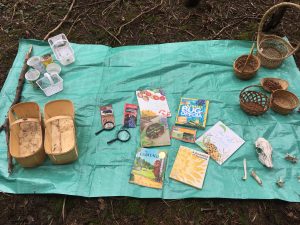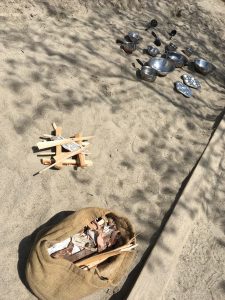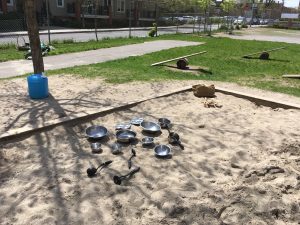
By Lara Purvis, Ottawa Forest and Nature School Educator
Hey educators! How heavy is your backpack when you hike out with the children? Are you carrying all the things? Do you double back because you forgot a little something?
 Within forest and nature school pedagogy loose parts are materials educators offer to support play and provoke learning. They are multi-use and open-ended. They can be tools with which to build or pieces of a structure. They may be part of the landscape or they may create the landscape. Loose parts are valuable and useful additions to our play environment. They can also easily fill up our backpacks.
Within forest and nature school pedagogy loose parts are materials educators offer to support play and provoke learning. They are multi-use and open-ended. They can be tools with which to build or pieces of a structure. They may be part of the landscape or they may create the landscape. Loose parts are valuable and useful additions to our play environment. They can also easily fill up our backpacks.
There is no list of “must have” loose parts for forest and nature school. The richer the natural environment, the less we need. But if one hasn’t seen the way children can and will play in their natural space, then we may wonder if play is dependent on what we carry out with us.
Some educators might find comfort in carrying more materials out into the forest. If the goal is to get outside, and a backpack filled with stimulating materials makes it feel easier to do so, than that heavy backpack is helping you do something wonderful.
But you may find – with time and regular repeated access to the same natural spaces – that your backpack of materials feels less and less necessary. You may find the natural space, increasingly, is enough to spark play for your children. That as soon as you say, “go play!” they’re gone and deeply engaged, because they’ve been planning all the way there and itching to get started.
We’re all different in our practice and the way we relate to loose parts. As educators we respond and adjust to our environment, our loose parts and the interests of the children every day.
 At the Ottawa Forest and Nature School loose parts around our cabin include pots and pans, baskets, digging tools, wooden stumps and boards. They all get a lot of regular and repeated use. The boards, for instance, are 2” x 8” mostly, good for fire circle seating, bridge building, teeter-totters and walking the plank on the pirate ship, among many other things.
At the Ottawa Forest and Nature School loose parts around our cabin include pots and pans, baskets, digging tools, wooden stumps and boards. They all get a lot of regular and repeated use. The boards, for instance, are 2” x 8” mostly, good for fire circle seating, bridge building, teeter-totters and walking the plank on the pirate ship, among many other things.
When we hike out in the forest, basics that we almost all carry out with us include: ropes, twine, knives, a bit of paper, art supplies and a couple of books.
One educator on our team will almost always include magnifying glasses, field guides, pulleys and weight-bearing ropes. He likes providing more options and his inclination towards building ziplines and elevators chairs is appreciated by the children.
However, I’m more inclined towards carrying the basics; I am so interested in seeing children’s play happen simply as a response to each other, their environment and their imaginations. Also I don’t mind a lighter bag, less achy shoulders and to have my hands free when they might be needed.
Responsive planning means adjusting what we carry based on interests that we see developing in our group. Extra ropes for slack-lines because you’ve got a particularly physical group and they need to climb and hang and hold on. Little hammers and goggles because you’ve got focused young miners searching for gold. Clipboards and different writing options alongside field guides if you’re looking to encourage literacy.
When our Ottawa Forest and Nature School educators led play in a grassy schoolyard, they brought a bundle of sticks, a pile of stumps, some tarps and ropes so those children could experience some of the richness of play they may encounter in the forest. When supporting play, without the rich natural environment, it made sense to bring more.



Loose parts can feel complicated only because they are so simple. But when we have access to forests, meadows, even a tangle of bush, it’s helpful to remember that can be enough. Children’s brains are designed to play and learn. Holding space for them to feel and respond to their environment in play is one of the ways we stay child-centred.
So – the next time you’re halfway down the trail and suddenly remember you didn’t bring the pots and pans you’d put aside, or the string and twine you’d planned, you can take a breath, smile and trust. The kids and the forest… they’ve got this.
***
Stay tuned for a Loose Parts Part 2 for inspiration and ideas on adding richness or shifting play in your group.

I appreciate your invitation to keep a balance – truth is, the forest is itself filled with loose parts! Over the years, we have found that when we build structures with rope/twine/wire that we brought, the structures were dismantled when we returned anyway (and we then had to find all the binding materials that were laying around in order to not contribute to a littered natural space). So now we build using gravity and the principles of balance only. Less litter, more experimentation!! We have also discovered that the children initially want the magnifying glasses and the field guides but then once they have explored a bit, want to change their focus and need their hands. Then I am left holding everything!! This is okay sometimes. But sometimes it is nice to be hands free myself. Like you said, it is about striking a balance.